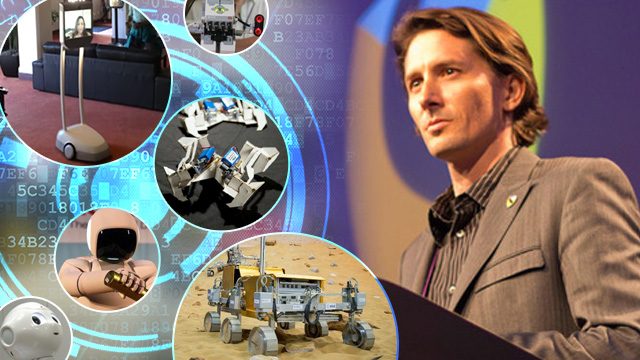SUMMARY
This is AI generated summarization, which may have errors. For context, always refer to the full article.

Part 2 of 3
Part 1: Rob Nail: A sci-fi future now
SAN FRANCISCO, USA – Imagine a future where robots do the majority of the work. People work at most 10 hours a week, but they still get basic income, what governments call monthly pay given unconditionally. It’s an experiment that will be tested in Kenya later this year and in the Netherlands, Finland, and Canada in 2017.
Imagine a world rid of all genetic disorders – and doctors using principles of genetic engineering to go a step further, changing the color of a person’s eyes, height, strength, and many more at will.
“We’re in control,” technologist Rob Nail tells me in his Silicon Valley office. “Our capability with CRISPR technology – we’re designing it. We’re here. That’s what we’re doing today.”
“We’re torn in a lot of different directions right now at the highest levels of ethics and morality,” he adds. “How do we make these decisions that are going to fundamentally change humanity? Who gets to make them? Who should be at the conversation?”
What it means to be human
43-year-old Rob Nail is excited about the future he sees now: where people can design human beings; and where he says the exponential growth of technology translates to virtually free energy, which impacts transportation, the price of food, access to education, and all we need to live in what he calls “a future of abundance.”

“That’s a world of abundance where everyone has equal access to not just the basics, but like middle and upper class basics,” he explains. “Then what do you do? Because at that point, robots are making food. Education is online. What do we do?”
“Meaning and purpose then,” I answer.
“Exactly!” he agrees. “That starts to be really important, and how we think about humanity at that point starts to be a really exciting and an interesting thing. Very scary to most people – incredibly exciting for me. Because I think that allows us to talk about what it means to be human.”
“What is really the purpose of humanity? And for me, where I go with that is I think the future of humanity is to explore the big questions: Why are we here? What else is there? How does this thing work? How do we connect? And creativity, right? That’s it.”
The tech hipster CEO and associate founder of Singularity University says it’s time to start public discussions not just about the disruptive effects of technology but also about the infinite possibilities ahead.
“One of the biggest things I think is missing in the world is an articulation of this kind of future – one that is exciting that we can live into,” he tells me, making fun of science fiction films with doomsday scenarios and machines taking over the world.
“Who is talking about and spending time helping figure out the model for that future that we can live in?” he asks. “That’s a great transition. One of my greatest fears and my sense of urgency is that we have a tremendous amount of work to do over the next 20 to 30 years to get through this transition period to create a world of abundance.”
The future of jobs
He has first-hand experience in dealing with robots and artificial intelligence: one of the companies Nail co-founded, Velocity11, built automation equipment and robotics for cancer research and drug discovery before he sold the company and exited in 2007.

“I personally have a deep concern about the future of work and the future of jobs,” he says. “The technological disruption of jobs is a very real thing, and it’s always happened. And it will always happen. It’s nothing new. What’s new today is the pace: it’s accelerating!”
He lays out the arguments why in about 20 years, he says robots will take over most of our jobs.
“Every physical task,” he adds, “will be taken over by robots.”
He’s not the only one predicting that. Earlier this year, President Barack Obama warned Congress that robots will take over jobs that pay less than $20 an hour, placing about 62% of US jobs at risk.
“That doesn’t mean that there’s not going to be new jobs,” he says. “There will be, but when you say these jobs are going to be wiped out by technology, people would say, ‘Whoa! Let’s stop technology.’ Well, let’s figure out how to adapt and figure out what those new jobs are and make them happen sooner.”
Merging machines and humans
Robots are highly dependent on A.I. or artificial intelligence. Funding in A.I. startups increased more than 4 times to $681 million in 2015, from $145 million in 2011, according to market research firm CB Insights. It estimates an increase of up to 76% this year, bringing new investments to $1.2 billion in 2016.
Still many naysayers point out that there have been false starts, with a boom in the 1980s in A.I. investments that largely failed and is now known as the “A.I. Winter”.
In terms of consumer technology, many are familiar with Apple’s Siri (even though some pointed out it needed to be adapted to Filipino English).
A year and a half ago, Amazon announced the launch of a voice-activated speaker connected to the internet called Echo. Using this, you get a virtual assistant that can control your home devices connected to it, get you the latest news, or play your favorite music. All you have to do is ask Alexa.
Now Google is set to release its competitor, Google Home, which can tap into what some call the world’s largest A.I. – Google, fed with billions of data points from different consumer touch points.
How far this can go is hotly debated within the United States. Some, like Nail and his colleagues, believe it’s only a matter of time before machines become smarter than humans – a term they call the singularity. Others believe machines should always be subservient to humans, but the amount of data available now is staggering to imagine.
Leapfrog development
What happens in other parts of the world, especially developing countries like the Philippines?
Nail points out that technology gives emerging economies a chance to leapfrog development.
“One of the most exciting things about exponential technologies is that they are rapidly democratized,” says Nail. “So the tools to use CRISPR? Any country, any research lab at any university anywhere around the world has the capability to use it and do new things with it…It’s for emerging markets to decide – well, what do we want to be? Do we want to be the world’s leader in education or in genetic engineering or maybe in manufacturing? Because you can turn that on today with very swift policy decisions and investments.”
So what does the Philippines want to craft for the future?
Understanding technology and choosing the path ahead – that’s the challenge to policy makers and industry today. (To be concluded) – Rappler.com
Add a comment
How does this make you feel?
There are no comments yet. Add your comment to start the conversation.